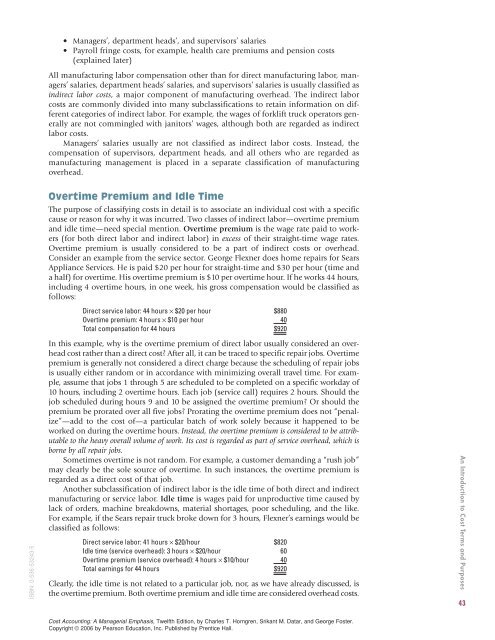2 an introduction to cost terms and purposes - Pearson Learning ...
2 an introduction to cost terms and purposes - Pearson Learning ...
2 an introduction to cost terms and purposes - Pearson Learning ...
You also want an ePaper? Increase the reach of your titles
YUMPU automatically turns print PDFs into web optimized ePapers that Google loves.
• M<strong>an</strong>agers’, department heads’, <strong>an</strong>d supervisors’ salaries<br />
• Payroll fringe <strong>cost</strong>s, for example, health care premiums <strong>an</strong>d pension <strong>cost</strong>s<br />
(explained later)<br />
All m<strong>an</strong>ufacturing labor compensation other th<strong>an</strong> for direct m<strong>an</strong>ufacturing labor, m<strong>an</strong>agers’<br />
salaries, department heads’ salaries, <strong>an</strong>d supervisors’ salaries is usually classified as<br />
indirect labor <strong>cost</strong>s, a major component of m<strong>an</strong>ufacturing overhead. The indirect labor<br />
<strong>cost</strong>s are commonly divided in<strong>to</strong> m<strong>an</strong>y subclassifications <strong>to</strong> retain information on different<br />
categories of indirect labor. For example, the wages of forklift truck opera<strong>to</strong>rs generally<br />
are not commingled with j<strong>an</strong>i<strong>to</strong>rs’ wages, although both are regarded as indirect<br />
labor <strong>cost</strong>s.<br />
M<strong>an</strong>agers’ salaries usually are not classified as indirect labor <strong>cost</strong>s. Instead, the<br />
compensation of supervisors, department heads, <strong>an</strong>d all others who are regarded as<br />
m<strong>an</strong>ufacturing m<strong>an</strong>agement is placed in a separate classification of m<strong>an</strong>ufacturing<br />
overhead.<br />
Overtime Premium <strong>an</strong>d Idle Time<br />
The purpose of classifying <strong>cost</strong>s in detail is <strong>to</strong> associate <strong>an</strong> individual <strong>cost</strong> with a specific<br />
cause or reason for why it was incurred. Two classes of indirect labor—overtime premium<br />
<strong>an</strong>d idle time—need special mention. Overtime premium is the wage rate paid <strong>to</strong> workers<br />
(for both direct labor <strong>an</strong>d indirect labor) in excess of their straight-time wage rates.<br />
Overtime premium is usually considered <strong>to</strong> be a part of indirect <strong>cost</strong>s or overhead.<br />
Consider <strong>an</strong> example from the service sec<strong>to</strong>r. George Flexner does home repairs for Sears<br />
Appli<strong>an</strong>ce Services. He is paid $20 per hour for straight-time <strong>an</strong>d $30 per hour (time <strong>an</strong>d<br />
a half) for overtime. His overtime premium is $10 per overtime hour. If he works 44 hours,<br />
including 4 overtime hours, in one week, his gross compensation would be classified as<br />
follows:<br />
Direct service labor: 44 hours × $20 per hour $880<br />
Overtime premium: 4 hours × $10 per hour 40<br />
Total compensation for 44 hours $920<br />
ISBN: 0-536-53243-5<br />
In this example, why is the overtime premium of direct labor usually considered <strong>an</strong> overhead<br />
<strong>cost</strong> rather th<strong>an</strong> a direct <strong>cost</strong>? After all, it c<strong>an</strong> be traced <strong>to</strong> specific repair jobs. Overtime<br />
premium is generally not considered a direct charge because the scheduling of repair jobs<br />
is usually either r<strong>an</strong>dom or in accord<strong>an</strong>ce with minimizing overall travel time. For example,<br />
assume that jobs 1 through 5 are scheduled <strong>to</strong> be completed on a specific workday of<br />
10 hours, including 2 overtime hours. Each job (service call) requires 2 hours. Should the<br />
job scheduled during hours 9 <strong>an</strong>d 10 be assigned the overtime premium? Or should the<br />
premium be prorated over all five jobs? Prorating the overtime premium does not “penalize”—add<br />
<strong>to</strong> the <strong>cost</strong> of—a particular batch of work solely because it happened <strong>to</strong> be<br />
worked on during the overtime hours. Instead, the overtime premium is considered <strong>to</strong> be attributable<br />
<strong>to</strong> the heavy overall volume of work. Its <strong>cost</strong> is regarded as part of service overhead, which is<br />
borne by all repair jobs.<br />
Sometimes overtime is not r<strong>an</strong>dom. For example, a cus<strong>to</strong>mer dem<strong>an</strong>ding a “rush job”<br />
may clearly be the sole source of overtime. In such inst<strong>an</strong>ces, the overtime premium is<br />
regarded as a direct <strong>cost</strong> of that job.<br />
Another subclassification of indirect labor is the idle time of both direct <strong>an</strong>d indirect<br />
m<strong>an</strong>ufacturing or service labor. Idle time is wages paid for unproductive time caused by<br />
lack of orders, machine breakdowns, material shortages, poor scheduling, <strong>an</strong>d the like.<br />
For example, if the Sears repair truck broke down for 3 hours, Flexner’s earnings would be<br />
classified as follows:<br />
Direct service labor: 41 hours × $20/hour $820<br />
Idle time (service overhead): 3 hours × $20/hour 60<br />
Overtime premium (service overhead): 4 hours × $10/hour 40<br />
Total earnings for 44 hours $920<br />
Clearly, the idle time is not related <strong>to</strong> a particular job, nor, as we have already discussed, is<br />
the overtime premium. Both overtime premium <strong>an</strong>d idle time are considered overhead <strong>cost</strong>s.<br />
An Introduction <strong>to</strong> Cost Terms <strong>an</strong>d Purposes<br />
43<br />
Cost Accounting: A M<strong>an</strong>agerial Emphasis, Twelfth Edition, by Charles T. Horngren, Srik<strong>an</strong>t M. Datar, <strong>an</strong>d George Foster.<br />
Copyright © 2006 by <strong>Pearson</strong> Education, Inc. Published by Prentice Hall.

















